Lasers for Solar Energy
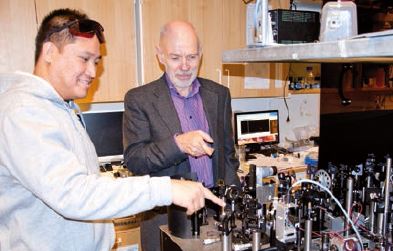 |
| Carlito S. Ponseca Jr. and Villy Sundström in a laboratory at Lund Laser Centre |
-
Perovskite solar cell materials probed by ultrafast terahertz spectroscopy
-
Tabletop soft X-ray device for probing molecular fine structure in solar materials
-
Molecular doping of organic semiconductors for photovoltaics
-
Raman spectroscopy reveals chemical reactions in plastic solar cells
-
Charge transfer processes in dye-sensitised solar cells revealed
-
Real-time movies of light-to-current conversion in organic solar cells
- Fuel from the sunlight: Learning from Nature
Only a small fraction of the incident solar radiation is needed to cover the global energy demand. As such, solar energy has a huge potential as a sustainable source of energy. Indeed, the percentage of electricity generated from sunlight has grown quickly over the past few years, mainly because of the highly successful crystalline silicon solar cells. In order to sustain this growth, though, the world needs new solar technologies, which can provide cheaper and – quite literally – more flexible solar materials.
Various kinds of thin-film and organic (‘plastic’) solar technologies are currently under investigation. They offer huge potential for low-cost solar energy production, as they can be produced on a large scale from solution by so-called roll-to-roll processing, much like newspapers are printed. In addition, these alternative technologies offer nearly endless possibilities to tune the optical absorption by changing dyes, dopants, or the structure of the organic molecules used. In order to find out which combination of materials – and in which configuration – gives the best results, detailed understanding of the physical and chemical processes inside the solar material is of crucial importance. And since those processes take place at ultrashort timescales (billionths of a billionth of a second) and the lengthscale of atoms, exceedingly fast and accurate measurements are required.
Fortunately, modern laser science provides the tools needed to follow the fundamental processes of solar electricity generation: the liberation of electrons (and their positively charged counterparts, called ‘holes’) from the active material by impinging photons, and their subsequent separation towards the electrodes. This focus section features stories from several scientists within Laserlab-Europe, partners as well as users, giving a flavour of the solar technologies under study and the laser techniques that are used to look into their workings.
Perovskite solar cell materials probed by ultrafast terahertz spectroscopy
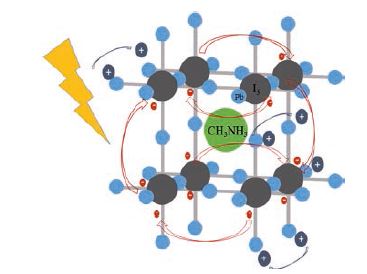 |
|---|
|
Figure 1: Organometal halide perovskite structure showing the three
|
The past few years have witnessed the rise of a spectacularly promising new photovoltaic material: organometal halide perovskite. Researchers at Lund Laser Centre (LLC, Sweden) explored how charge carriers (electrons and holes) move inside this novel material once they are liberated by sunlight. In the short span of three years, the overall power conversion efficiency (PCE) of organometal halide perovskite (OMHP) solar cells have shot up from 7.3 % to 19.3 %. This sharp rise of the power conversion efficiency is unprecedented and unmatched by any other solar cell technology since the conception of harvesting sunlight. As a result, the solar cell community is in great excitement and many of its researchers have shifted to the study of this material.
Unlike silicon solar cells, which require highly industrialised settings for fabrication, this material can be prepared in the laboratory (kitchen chemistry) where a three dimensional mesoscopic scale structure can be achieved. Several different configurations of the OMPH have been explored for solar cells – as sensitiser of nanostructured metal oxides (e.g., TiO2), porous thin films, vapour deposited thin solid films, etc.
Scientists at the Lund Laser Centre, in collaboration with researchers in Delft and Geneva, have explored the charge carrier dynamics in these new materials employing a combination of ultrafast THz and optical spectroscopy. Some of its nearly ideal solar cell characteristics reported include ultrafast generation of excitons (around 100 femtoseconds), which then separate into highly mobile charges in 2-3 picoseconds.
Electron and hole mobilities in neat OMPH were estimated to be 12.5 cm2/Vs and 7.5 cm2/Vs, respectively, at least two orders of magnitude higher than in organic solar cells, and remain mobile up to the microsecond timescale, beating organic solar cells by at least three orders. Not only the exciton binding energy is small (around 35 meV), thereby allowing fast dissociation of bound electron-hole pairs, but it also requires 90 meV of activation energy for these charges to recombine. This leads to very slow charge recombination and micrometre scale electron and hole diffusion lengths, again winning over organic solar cells by at least three orders of magnitude.
When used as sensitiser to a nanostructured TiO2 electrode, ultrafast, < 1 ps, electron injection from perovskite to TiO2 is observed (figure 2), leading to long lived charge carriers that can be efficiently extracted as photocurrent. Several avenues are currently being explored in order to push overall power conversion efficiency further. This includes looking for higher conductivity hole transporting materials, optimizing growth processes for more uniform morphology of the perovskite, and using perovskite-based cells in tandem with silicon solar cells.
Carlito S. Ponseca Jr. and Villy Sundström
Tabletop soft X-ray device for probing molecular fine structure in solar materials
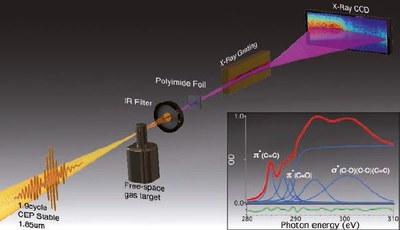 |
|---|
| Sub-2-cycle pulses are focused into a high pressure gas target, generating water window high harmonics. Absorption spectra from a polyimide film are recorded using an X-ray spectrograph. Taken from: S. L. Cousin et al., Optics Letters 39, 5383 (2014). |
At ICFO, Barcelona, the first tabletop ultrafast X-ray absorption measurements were recently demonstrated using a high harmonic generation (HHG) laser source in the water window. This source is now available through the Laserlab access programme and is particularly suited for looking at excitations and structure of organic solar cell materials.
Control and catalysis of a chemical reaction, or efficient conversion of a photon from sunlight into an electronic current within a solar cell, require precise coordination of the numerous steps across energetic barriers and along complicated reaction pathways. In order to understand and steer these processes, we need new quantitative experimental tools that can track time-evolving structural changes and electronic excitations in a comprehensive manner, i.e., we have to get access to the initiation reactions without missing any of the fastest dynamics (taking place at attosecond timescales) or smallest structural changes (at the Ångstrom level). The wavelength range from 2.3 to 4.5 nm, called the ‘water window’ because water is nearly transparent in this range, is of great interest to scientists since the so-called K-absorption edges of the building blocks of life, carbon, nitrogen and oxygen all fall within this wavelength range. These so-called soft X-rays can thus be incredibly useful for element-specific high resolution imaging and spectroscopy. Facility scale light sources, namely synchrotrons and X-ray free electron lasers, have so far been the only sources of these extreme short wavelengths. High harmonic generation (HHG), however, can be an alternative compact and economic source of short wavelength radiation on attosecond time scales.
We have recently demonstrated a high flux source of water window radiation and used it to perform high resolution X-ray absorption spectroscopy on a polyimide foil, in which we identify specific absorption features corresponding to the binding orbitals of the carbon atoms. Absorption spectra are recorded in single five-minute integrations, highlighting the high number of X-ray photons generated. The measurements indicate that our tabletop X-ray source is particularly suited for unraveling the processes leading to the generation of electricity in organic (i.e., carbonbased) solar cells.
Jens Biegert
Molecular doping of organic semiconductors for photovoltaics
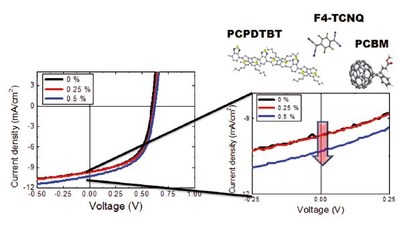 |
|---|
|
Current-voltage characteristics of PCPDTBT:PCBM solar cells which were doped with |
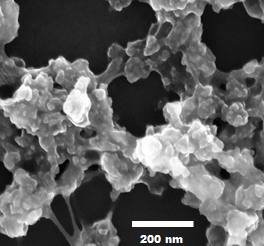 |
|---|
| Scanning electron microscopy (SEM) image of a thin film of the material MEH - PPV, doped with silica nanoparticles to induce morphological changes which increase hole mobility in organic field effect transistors. |
The power conversion efficiencies of organic solar cells have been increasing rapidly due to the design of new organic absorber materials, but the performance of bulk heterojunction solar cells is still inherently limited by the electronically disordered active layer. At Laser- LaB Amsterdam, the effect of introducing molecular electron donors and acceptors into the semiconductor material – a process called ‘doping’ – is studied in detail.
The most widely investigated type of organic solar cell is the polymer:fullerene bulk heterojunction. Soluble polymer and fullerene derivatives are processed from a single solution onto a substrate. Phase segregation between the molecular phases ensures an extended interface for efficient charge separation as well as closed percolation paths for the transport of charge to the electrodes. One of the biggest challenges to improve solar cell efficiency is to correlate the structure of the complex active layer with the opto-electronic response of the device.
Doping, i.e., introducing electron donors and acceptors into semiconductors, is a strategy which has been widely investigated to improve the electrical properties of inorganic semiconductors. Molecular dopants are strong electron acceptors which will induce electron transfer when introduced into an organic layer, resulting in p-type doping of the organic semiconductor. This concept has been receiving increasing attention for application in organic electronics. Together with project partners we demonstrated that molecular dopants can be applied to the active layer of polymer:fullerene solar cells based on the low band gap material PCPDTBT. This material has good optical absorption properties for organic photovoltaics, but low carrier mobility values due to the intrinsic electronic disorder of thin PCPDTBT films.
We demonstrated that doping PCPDTBT films with the electron acceptor F4-TCNQ at low concentrations (much less than 1 weight %
compared to the polymer) leads to an increase in hole mobility, which was attributed to filling electronic traps in the polymer film by dopant induced charge. In the case of PCPDTBT:fullerene blends, molecular doping with F4-TCNQ was observed to reduce carrier recombination phenomena at the polymer:fullerene interface, leading to efficient charge separation. Proof-of-concept solar cells fabricated from doped PCPDTBT:fullerene blends demonstrated increased photocurrents, leading to increased power conversion efficiencies.
We are a new group at LaserLab Amsterdam, and as a next step we plan to combine our expertise in electrical characterisation, i.e., impedance spectroscopy, with optical techniques such as transient absorption and Raman spectroscopy in order to correlate the energetics and dynamics of excited states in the organic layer with molecular properties, such as structure and morphology.
Elizabeth von Hauff
Raman spectroscopy reveals chemical reactions in plastic solar cells
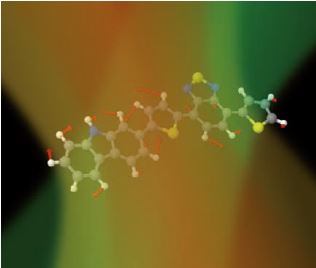 |
Femtosecond Stimulated Raman Spectroscopy (FSRS) requires three laser beams to record the structural changes occurring when the material is excited. First, a green pulse activates the polymer to create an electronic excited state. Then, a pair of near infra-red and white light continuum pulses are used to generate the Raman spectrum that records vibrational modes of the excited molecule. The ultrashort lasers pulses enable a time resolution of less than 300 femtoseconds. Credit: University of Montreal. |
|---|
In a recent access project, an international team of collaborators used the femtosecond lasers available on the Central Laser Facility’s ULTRA facility to look at the fundamental beginnings of chemical reactions in a new brand of photovoltaic diodes (organic or plastic solar cells), based on blends of polymeric semiconductors and fullerene derivatives.
The access project, which was published in Nature Communications in July 2014 (5, 4288), involved teams from the University of Cyprus, the University of Montreal (Canada), Imperial College, and the CLF. It used the ultrafast method of ‘Femtosecond Stimulated Raman Spectroscopy’ (FSRS), in which laser beams of three different colours are sent onto the solar material, and the subsequently emitted light is collected, revealing details of the internal molecular structure and the processes that took place after the absorption of the laser light. In ‘plastic’ solar cells, the absorption of light fuels the formation of a free electron and a positive charged species, called a ‘hole’. To ultimately provide electricity, these two species must separate, allowing the electron to move towards the electrode. If the electron is not able to move away fast enough then the positive and negative charges simply recombine and the energy is lost to us. The efficiency of the solar cell thus depends on the fraction of electrons of an electron-hole pair that makes it to the edge of the active material.
Our study provides two key insights into the mechanism of the charge transfer process governing the efficiencies of solar energy devices. Firstly, the work establishes that in the initially created ion pair – generated from the excited state created by photon absorption – the electron moves away from the positive centre, leading to a prompt molecular rearrangement, with the molecular system resembling the final products within around 300 femtoseconds.
Secondly, we noted that any ongoing relaxation and molecular reorganisation processes following this initial charge separation, as visualised using the FSRS method, should be extremely small. These findings open avenues for future research into understanding the differences between material systems that actually produce efficient solar cells and systems that should be as efficient but in fact do not perform as well, perhaps because a molecule’s structural rearrangement is too slow to stabilise and maintain charge separation. A greater understanding of what works and what doesn’t will obviously enable better solar panels to be designed in the future.
Tony Parker
Artificial photosynthesis: creating solar fuels
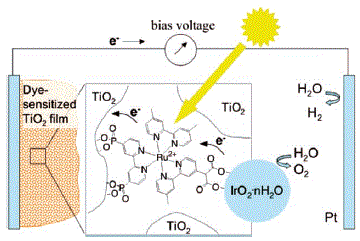 |
|---|
| Schematic of an artificial photosynthetic system |
In addition to using sunlight to produce electricity or heat, solar energy can also be used to create fuels. At LaserLaB Amsterdam, efforts are undertaken to understand the basic steps of a process which takes its inspiration from nature: artificial photosynthesis.
Over the past decades, the use of solar energy has been on the rise but has been limited to electric conversion through photovoltaic cells and photothermal methods (using solar heat). However, the sun doesn’t always shine and it is very difficult to store electrical energy. For this reason, our society is to a major extent built around the use of fuels rather than electricity. Artificial photosynthesis, also termed solar fuel production, can remedy this situation: here the energy from sunlight is directly converted to a fuel which can be easily stored. We take our inspiration from natural photosynthesis, where electrons and protons are taken from water and used to generate high-energy organic compounds. We can mimic the basic steps using molecular assemblies similar to those found in photosynthesis, use solid state semiconductors with the right properties or even biohybrid devices.
However, large knowledge gaps exist today on how to efficiently store solar energy in fuels: present-day artificial photosynthesis devices do not perform greatly and are generally not very stable in sunlight. We do not understand these poor qualities at all because we have no idea what happens with the energy and charges once a solar photon has been absorbed. Charge recombination processes arising from bare thermodynamics compete with every forward step, meaning that completion of a successful water-splitting and fuel-production cycle literally is a race against time! Here, advanced laser spectroscopy enters the game. Using lasers we can determine and control pathways and mechanisms of energy and charge transfer processes, and identify the loss processes that get in the way of the performance of solar fuel devices. At LaserLaB Amsterdam, we run a research programme to address these issues through the application of advanced time-resolved spectroscopic methods.
Unique features of the experimental approach include access to the entire time span between photon absorption and catalytic turnover, i.e., from femtoseconds to milliseconds, infrared and Raman detection methods that provide molecular specificity and information on local structure, and multi-pulse capability to manipulate the dynamics of catalytic intermediates with preservation of time resolution. Detailed knowledge about the pathways and (loss) mechanisms of energy and charge transfer will help in a design steering feedback loop with organic chemistry, supramolecular catalysis, and solid-state surface catalysis groups to optimise the performance of artificial photosynthetic modules.
John Kennis
Charge transfer processes in dye-sensitised solar cells revealed
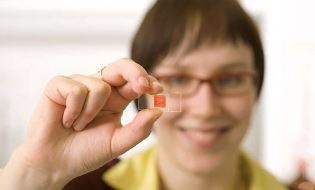 |
|---|
| Dr. Liisa Antila with a dye sensitised solar cell. © Petri Blomqvist |
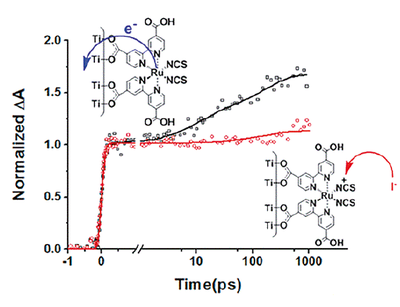 |
|
Charge recombination in N719 sensitised DSC after excitation at |
Dye-sensitised solar cells (DSC), thin film cells which can be built from cheap materials and could be costeffectively processed by roll-to-roll manufacturing, have been the focus of intensive studies since the invention of the concept a quarter of a century ago. Finnish Laserlab-Europe User Representative Jouko Korppi- Tommola and his team have been studying these solar cells for almost two decades, making use of several Laserlab-Europe access facilities to unravel their inner workings.
For a long time, the efficiency of dye-sensitised solar cells, mostly using ruthenium-based dyes, improved only marginally, remaining around the magic 10%. Unexpectedly, a new light absorbing perovskite material was introduced in 2012. The concept developed rapidly and new records have appeared in quick succession, leading to a veritable perovskite solar cell boom. However, there is no fundamental understanding of charge transfer processes in perovskite solar cells yet, and the development of perovskite- based cells may greatly benefit from previous work on DSCs, where we have been active for a long time.
Our research group at the Nanoscience Center of the University of Jyväskylä entered the study of fundamental charge transfer processes of DSCs after being able to get one of the first 1kHz amplified Ti:sapphire lasers in Europe in the lab in 1996. Soon we realised that there are two charge transfer regimes for the electrons to go from the sensitiser dye to the titanium oxide semiconductor, one faster than 100 femtoseconds and the slower one lasting from a few picoseconds to about 100 picoseconds. Since our time resolution at that time was not good enough to resolve the sub 100 femtosecond injection, contact was sought with Lund Laser Centre (Villy Sundström). Access days were granted and the first Laserlab-Europe visit realised. Two smart students, Gabor Benkö (Lund) and Jani Kallioinen (Jyväskylä), had the Lund laser working for two weeks at sub 30 femtosecond time resolution, which allowed resolving the fast injection rate and consequently writing the full story for electron injection dynamics in the ruthenium dye based DSCs in 2002. The papers have become the landmark in the field.
Work continued in search of new ruthenium dyes that were delivered by the chemists from the University of Eastern Finland. These dyes span two more Laserlab-Europe access visits: one to MBI (Berlin) with Erik Nibbering and one to CUSBO (Milan) with Giulio Cerullo. The mid-infrared instrumentation available at MBI was used to unravel vibronic details of the photoreactions of the dyes, revealed the potential of mid-infrared technology. Better time resolution than available either in Jyväskylä or at MBI was still needed and this was found at CUSBO, where newly developed 30 femtosecond UV pulses were used for excitation, and their 7 femtosecond pulses for probing. Again a complete picture was obtained. Work on DSCs in Jyväskylä continued with use of atomic layer deposition (ALD) in hope to generate subnanometre barrier layers on the photo-electrode that would slow down recombination reactions of the cell. Aluminum, hafnium and tantalum oxide layers were studied. In 2010, mid-infrared instrumentation became operational for 1DIR and 2DIR measurements in Jyväskylä. By combining the results from probing the dye cation formation on the photoelectrode by using near-infrared pulses, and accumulation of electrons in the titanium oxide conduction band by using the mid-infrared pulses, we were able to unravel the first charge regeneration steps of the DSCs, 22 years after the invention of the cell.
This is a good example of how science proceeds in steps with unpredictable timespan between the steps of advancement. To get understanding of fundamental phenomena underlying a seemingly simple function, in this case current production of the cell, one has to have good partners and excellent equipment to solve the problem. This is where Laserlab-Europe access has helped us a lot. The visit to CUSBO in 2004 determined my fate to become involved in Laserlab user activities. Sandro De Silvestri asked me if I would be interested. Now, ten years later, I hope that I have been able to convey my experiences as a user to the user community of Laserlab-Europe, and I hope to be able to continue doing so.
Jouko Korppi-Tommola
Real-time movies of light-to-current conversion in organic solar cells
One of the key challenges that mankind has to face in this century is to devise sustainable and clean methods for the production of renewable energy. A recent access project, in which scientists from the University of Oldenburg collaborated with the Ultrafast Spectroscopy group of Giulio Cerullo from Laserlab-Europe partner CUSBO in Milan, has led to an exceptional insight in how light is converted to electrical energy in organic photovoltaic devices (‘plastic solar cells’). As demonstrated by ‘quantum movies’ provided by theorists from the Italian Istituto Nanoscienze, quantum coherence seems to play an important role in the energy conversion process. This new understanding could be used to guide the design of future artificial light-harvesting systems.
Sunlight is a very abundant source of clean energy, but it is intrinsically diffuse. Natural photosynthetic systems have, in the course of evolution, developed sophisticated and highly efficient molecular architectures capable of harvesting the solar energy and storing it into chemical bonds, with an efficiency yet unmatched by any artificial device. One of the key challenges for renewable energy research is to learn how to construct artificial molecular devices which, following the blueprint of natural ones, are able to exploit sunlight either for direct electric power generation (photovoltaic approach) or to drive photochemical reactions which produce fuels (photosynthetic approach).
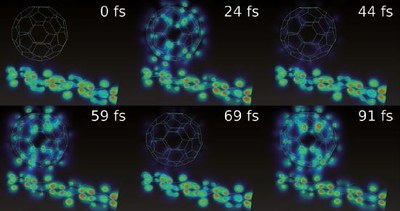 |
|---|
| Frames taken from the quantum simulation of a portion of an organic solar cell composed by a polymer chain, and a fullerene buckyball. The two parts of the system, separated by a small space,act as the poles of a microscopic sun-operated battery. The quantity depicted illustrates the wavelike oscillations of an electron after sunlight is absorbed at time 0. The time scale is in femtoseconds (fs). Each frame depicts a scene about 2 nanometers wide. By Dr. Carlo Andrea Rozzi (CNR - Istituto Nanoscienze Centro S3, Modena). |
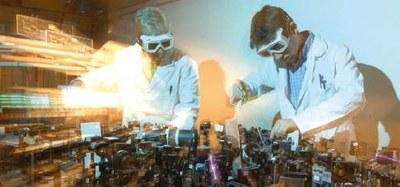 |
| Tunable few-optical-cycle pulse generation: the ultrafast spectroscopy setup at CUSBO. |
Traditionally, the primary processes occurring in natural photosynthetic systems, both bacteria and higher plants, have been interpreted in terms of the incoherent energy flow between the different molecular species to the reaction center where charge separation takes place. Very recently a paradigm shift has occurred in the understanding of such processes, indicating that quantum coherence, i.e., the wavelike motion of electronic wave packets, plays a key role in natural photosynthesis. It seems as if nature has designed the molecular complexes in such a way as to protect the typically very fragile quantum coherence and to exploit it to optimize the efficiency of photosynthetic light harvesting. This new understanding, which has been obtained thanks to advanced ultrafast optical spectroscopy techniques, challenges the way we think about natural photosynthesis, and gives rise to the obvious question whether such coherent effects are also present in artificial light-harvesting systems, and can be exploited to optimize their performance.
Looking for an answer to this very fundamental question, Prof. Christoph Lienau (University of Oldenburg, Germany) performed a series of experiments, in the framework of a Laserlab-Europe access project, at the CUSBO (Center for Ultrafast Science and Biomedical Optics) facility in Milan. The goal of these studies, performed in cooperation with the Ultrafast Spectroscopy group led by Prof. Giulio Cerullo, was to investigate, with an unprecedented sub-10- fs temporal resolution, the dynamics of the charge separation process in a prototypical organic photovoltaic (OPV) material consisting of a polymer-fullerene blend.
OPV solar cells typically consist of nanostructured blends of conjugated polymers (long chains of carbon atoms), acting as light absorbers, and fullerenes (carbon buckyballs), acting as electron acceptors. With respect to their traditional inorganic counterparts, OPV cells have particularly favorable properties. They are low-cost, lightweight and flexible, and their colour can be adapted by varying the material composition.
The primary and most elementary step in the lightto- current conversion process in OPV cells, light-induced transfer of an electron from the polymer to the fullerene, occurs at such a staggering speed that it has previously proven difficult to follow it directly. Exploiting the unique ultrafast spectroscopy facility developed at CUSBO, which uses different ultra-broadband optical parametric amplifiers to achieve sub-10-fs time resolution combined with broad spectral tunability from the visible to the infrared, the researchers from Oldenburg and Milano were able to record “real-time movies” of the light-to-current conversion process in an OPV cell. In a report published in the May 30 issue of Science Magazine, the researchers show that the quantum-mechanical, wavelike nature of electrons and their coupling to the nuclei is of fundamental importance for the charge transfer in an OPV device.
“Our initial results were actually very surprising”, says Christoph Lienau. “When using sub-10-fs light pulses to illuminate the polymer layer in an organic cell, we found that the light pulses induced oscillatory, vibrational motion of the polymer molecules. Unexpectedly, however, we saw that also the fullerene molecules all started to vibrate synchronously. We could not understand this without assuming that the electronic wave packets excited by the light pulses would coherently oscillate back and forth between the polymer and the fullerene.”
All colleagues with whom the scientists discussed these results were initially skeptical. “In such OPV blends, the interface morphology between polymer and fullerene is very complex and the two moieties are not covalently bound”, says Lienau, “therefore one might not expect that vibronic coherence persists even at room temperature. We therefore asked Elisa Molinari and Carlo A. Rozzi, of the Istituto Nanoscienze of CNR and the University of Modena and Reggio Emilia, for help.”
A series of sophisticated quantum dynamics simulations, performed by Rozzi and colleagues, provided movies of the evolution of the electronic cloud and of the atomic nuclei in this system, which are responsible of the oscillations found in experiments. These calculations indicated that the coupling between electrons and nuclei is of crucial importance for the charge transfer efficiency.
Tailoring this coupling by varying the device morphology and composition hence may be important for optimising device efficiency. The question remains whether these new results will immediately lead to better solar cells. “Such ultrafast spectroscopic studies, and in particular their comparison with advanced theoretical modelling, provide impressive and most direct insight in the fundamental phenomena that initiate the OPV process. They turn out to be very similar to the strategies developed by nature in photosynthesis, exploiting quantum coherence to optimize the efficiency of light harvesting”, says Christoph Lienau. “Our new result, enabled by the unique experimental capabilities available at CUSBO and by the Laserlab-Europe programme, provides evidence for similar phenomena in functional artificial photovoltaic devices: a conceptual advancement which could be used to guide the design of future artificial light-harvesting systems in an attempt to match the yet unrivalled efficiency of natural ones.”
Giulio Cerullo
Fuel from sunlight: learning from nature | LaserLaB Amsterdam
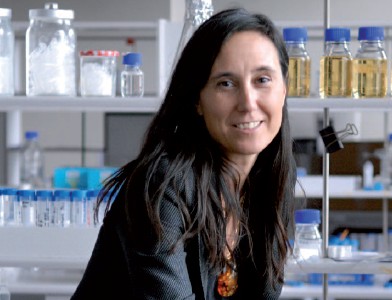 Roberta Croce |
The Sun is the Earth's primary energy source. The energy stored in fossil fuels is basically stored sunlight - converted to chemical energy by plants and algae millions of years ago. Photosynthesis, the process in which plants and algae use sunlight to create energy-rich sugars from water and CO2, may therefore be key to finding a substitute for the depleting resources of fossil energy. Detailed laser measurements on the absorption of light by the pigments involved in photosynthesis are paramount for our understanding of this life-giving process. Roberta Croce, professor of Biophysics of Photosynthesis/Energy at LaserLaB Amsterdam since March 2011, is one of the researchers within Laserlab- Europe who are trying to understand the details of photosynthesis in the quest for a sustainable energy source for humankind. Recently, she received an ERC Starting Grant to fund her research. |
Croce wants to understand how photosynthesis works for two reasons, she says: "First we might be able to copy nature and build our own photosynthetic systems that can produce fuels from sunlight. But with this same knowledge, one could also manipulate and improve existing systems, such as plants and algae."
The Italian researcher got acquainted with LaserLaB when she visited the lab for a month as part of a Laserlab-Europe Access project. As a professor at Laser LaB Amsterdam, she mainly concentrates on the question how the natural photosynthetic system adapts to changing light conditions. At low sunlight, plants crave for every photon reaching their leaves. On the other hand: in full sunlight, plants need strategies to avoid damage due to high light intensities.
Several things can happen with the light a plant receives, explains Croce. The energy contained by the light can be converted to heat, the energy can be emitted again as light with a longer wavelength (fluorescence), it can be stored in sugars (photosynthesis), or it can create so-called free radicals; harmful molecules that will damage the plant from the inside. Croce: "In order to increase the yield of existing crops, whether for food or biofuel, we need to know how we can increase the amount of sunlight used for photosynthesis while avoiding the creation of free radicals."
In the framework of the Dutch national project 'towards biosolar cells', Croce studies high yield carbon fixation plants, which grow up to three times as fast as ordinary plants. This is due to their capacity to handle high light intensities. Croce: "We study those plants in order to find out how they can still use light very efficiently also in very bright light. If we find the mechanisms involved, we might be able to use them to increase the yield of food or biomass from crops."
Croce also collaborates with researchers who grow algae in bioreactors. Those algae could be used either as biomass directly, or could be programmed to produce biofuels. A complicating factor is that – due to the density of algae – only the upper layer of algae is reached by sunlight. "Actually, the upper layer of algae receives too much sunlight, whereas the remainder of the algae see no sunlight at all. To solve this problem, we are looking for ways to decrease the size of the so-called light-harvesting complexes of the algae. That would make the algae more 'transparent', resulting in a more even distribution of light between the algae." In order to accomplish this, part of the proteins from the light-harvesting complex should be removed – but not those proteins essential for the photosynthetic process itself. "We combine genetic modification of the algae with spectroscopic techniques to assess the effect of each modification and to find out which proteins can be safely left out."
Croce received an ERC Starting Grant in 2011 to study so-called acclimation mechanisms in algae and plants that allow them to cope with changes in light intensity and nutricients, avoiding photodamage. "Many people study this, but mainly in vitro. It is hard to link those results to what happens in reality." In order to gap this bridge between 'in vitro' and 'in vivo', Croce will use fluorescence spectroscopy to study the behaviour of various types of modified plants and algae. In that way she hopes to find out how the desirable acclimation mechanisms can be promoted.
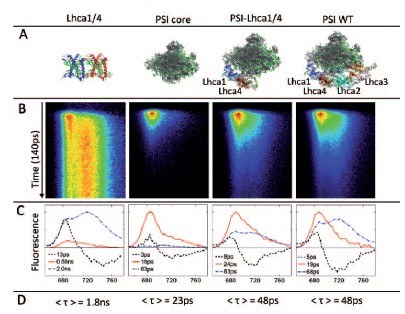
Time-resolved (ps) fluorescence experiments on photosynthetic complexes with different antenna sizes.

